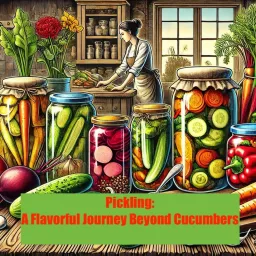Pickling: A Flavorful Journey Beyond Cucumbers

The Art of Pickling: A Flavorful Journey Beyond Cucumbers
Pickling is a time-honored tradition that transforms ordinary vegetables and fruits into tangy, crisp delicacies. While many associate pickling solely with cucumbers, this versatile preservation method can be applied to a wide array of produce, creating a pantry full of colorful, zesty treasures. Let's embark on a culinary adventure to explore the world of pickling and discover how to elevate your home cooking with these delightful preserved morsels.
At its core, pickling is the process of preserving food in an acidic medium. This can be achieved through fermentation, where natural bacteria produce lactic acid, or by adding vinegar to create a brine. The acidity not only preserves the food but also imparts that characteristic tangy flavor we associate with pickles. This ancient method of food preservation has been practiced for thousands of years, with evidence of pickling dating back to 2030 BCE in the Tigris Valley of India.
Before diving into the pickling process, it's essential to ensure your kitchen is properly equipped. High-quality glass jars with tight-fitting lids are a must, as is a large pot for boiling filled jars. A jar lifter is invaluable for safely removing hot jars from boiling water, while a canning funnel helps fill jars neatly. You'll also need a nonreactive saucepan for preparing brines and a sharp knife for precise cutting of vegetables and fruits. Some enthusiasts also invest in a mandoline for uniform slicing, particularly useful for vegetables like cucumbers and onions.
The beauty of pickling lies in its simplicity. Always choose the freshest vegetables or fruits for the best results. When selecting produce, look for items that are firm and free from blemishes. Cucumbers for pickling should be small and compact, with thin skins and minimal seeds. Vinegar forms the base of most pickling brines, with white, apple cider, or rice vinegar all being suitable options. Each type of vinegar imparts a unique flavor profile to your pickles, so don't be afraid to experiment.
Salt is crucial in pickling, but be sure to use pickling or kosher salt, avoiding iodized varieties which can cause discoloration and cloudiness in your brine. Sugar can be added to balance the acidity, though it's optional. Brown sugar or honey can be used for a more complex sweetness. Whole spices like mustard seeds, peppercorns, and dill seeds, along with fresh herbs such as dill, thyme, or bay leaves, add depth and complexity to your pickles. Garlic and ginger are also popular additions that can significantly impact the final flavor.
The pickling process begins with preparing your produce by washing and cutting it into desired shapes. For cucumbers, you might leave them whole for dill pickles, or slice them into spears or rounds for bread-and-butter pickles. Onions can be sliced into rings or quarters, while carrots might be cut into sticks or rounds. Next, create the brine by combining vinegar, water, salt, and any sugar or spices in a saucepan and bringing it to a boil. The ratio of vinegar to water can vary depending on the recipe, but a common starting point is equal parts vinegar and water.
While the brine heats, fill sterilized jars with your prepared produce and any additional spices or herbs. Packing the vegetables tightly helps prevent them from floating in the brine. Once the brine is ready, pour it over the produce, leaving a quarter-inch of headspace. This space is crucial as it allows for the expansion of the food during processing and creates a proper seal. Use a nonmetallic utensil to release any trapped air bubbles before sealing the jars and processing them in a boiling water bath if you're making shelf-stable pickles.
Quick pickles, also known as refrigerator pickles, offer a simpler alternative to traditional canning methods. These are made by pouring hot brine over produce and refrigerating. They're ready to eat within hours or days and will last for several weeks in the refrigerator. This method is perfect for small batches or when you want to experiment with flavors without committing to a large quantity.
On the other hand, fermented pickles rely on beneficial bacteria to create lactic acid. This process takes longer but results in complex flavors and potential probiotic benefits. Fermented pickles can last for months when properly stored. To make fermented pickles, vegetables are submerged in a salt brine and left to sit at room temperature for several days or weeks. During this time, beneficial bacteria convert the vegetable's natural sugars into lactic acid, which acts as a preservative and gives the pickles their characteristic tangy flavor.
While cucumbers are the most well-known pickle, a world of pickling possibilities awaits the adventurous cook. Carrots take on a vibrant crunch when pickled, perfect for adding to salads and sandwiches. Try flavoring them with cumin and coriander for a Moroccan twist. Red onions, when quick-pickled, brighten up tacos, burgers, and grain bowls with their vivid pink hue and zesty flavor. Don't discard those watermelon rinds – pickle them with cinnamon and cloves for a sweet and tangy treat reminiscent of the American South.
Green beans, when pickled, become crisp, savory snacks known as "dilly beans," which also make elegant garnishes for Bloody Marys. For a delightful balance of sweet and sour, try pickling peaches, which pair beautifully with grilled meats or as part of a cheese board. Whole cloves of pickled garlic develop a mellow, complex flavor that's wonderful in salad dressings or mashed into compound butter.
Mushrooms, particularly small button or wild varieties, make excellent pickles and are a welcome addition to antipasto platters. The earthy sweetness of beets is enhanced by pickling; try adding star anise to the brine for an intriguing flavor profile. Quick-pickled radishes retain their peppery bite while taking on a pleasing tanginess, making them delightful in tacos or as a garnish for rich dishes. And while not a vegetable, pickled eggs are a classic bar snack that deserves a place in your pickling repertoire.
The art of pickling allows for endless creativity in developing flavor profiles. Consider an Asian-inspired pickle using rice vinegar, ginger, and star anise for a delicate, aromatic result. Or explore Indian flavors with turmeric, mustard seeds, and fenugreek seeds for a warm, complex taste. A herbal infusion of tarragon, thyme, and lemon zest makes for a bright, herbaceous pickle, while brown sugar and red pepper flakes create an intriguing balance of heat and sweetness. For a smoky depth, try incorporating chipotle peppers and cumin into your brine.
To ensure pickling success, always use the freshest produce possible for the best texture and flavor. Maintain cleanliness throughout the process to prevent contamination. For crisp pickles, try soaking vegetables in ice water for a few hours before pickling. This helps to maintain their crunch even after pickling. Don't be afraid to experiment with different vinegars to find your preferred flavor profile, and consider keeping a pickling journal to record your recipes and adjustments.
Homemade pickles are versatile additions to your culinary repertoire. Arrange an assortment of pickled vegetables alongside cured meats and cheeses for an impressive charcuterie board. Layer pickled onions or carrots on sandwiches for added crunch and zing, or chop pickled vegetables and toss them into green salads or grain bowls for extra flavor. Use pickled pearl onions or cornichons to garnish cocktails like martinis or Gibsons, or finely chop a variety of pickled vegetables to create unique relishes for hot dogs or burgers. Pickled mushrooms or cauliflower make excellent appetizers as part of an antipasto platter. For a thoughtful, handcrafted gift, consider packaging your homemade pickles in decorative jars.
Beyond its culinary applications, pickling offers several health and environmental benefits. It allows you to preserve surplus produce that might otherwise go to waste, reducing food waste. This is particularly valuable if you have a vegetable garden that produces more than you can eat fresh. Fermented pickles can introduce beneficial bacteria to your diet, supporting gut health. These probiotics may aid in digestion and boost the immune system. By making your own pickles, you can control the amount of salt used, potentially reducing sodium intake compared to store-bought varieties.
Pickling also enables you to enjoy seasonal produce throughout the year. Imagine savoring the taste of summer tomatoes in the depths of winter, or enjoying crisp spring radishes when snow covers the ground. This connection to seasonality can help foster a greater appreciation for the natural cycles of food production. Moreover, pickling connects us to age-old food preservation techniques and cultural culinary practices. Nearly every culture around the world has its own pickling traditions, from German sauerkraut to Korean kimchi to Indian achaar.
As you delve deeper into the world of pickling, you may find yourself viewing your garden or farmers' market haul in a new light. Suddenly, every vegetable becomes a potential pickle, and your culinary creativity knows no bounds. You might start experimenting with unusual combinations, like pickled grapes with rosemary, or jalapeno-pickled pineapple for a spicy-sweet treat.
Start small with quick pickles, then gradually expand your repertoire to include fermented varieties and more unusual produce. You might begin with a simple batch of dill pickles, then move on to spicy pickled okra or tangy pickled cherries. Before long, you'll have a pantry full of colorful jars, each containing a unique flavor experience waiting to be savored.
Remember, pickling is both a science and an art. While it's importan































